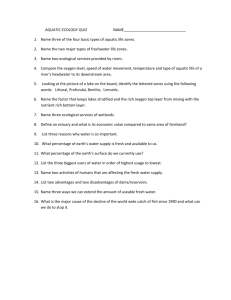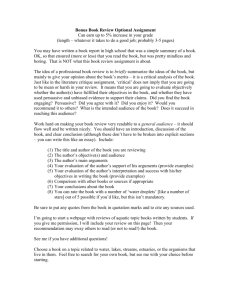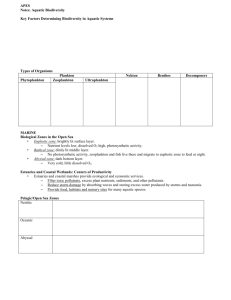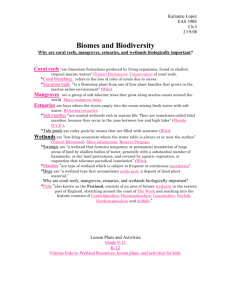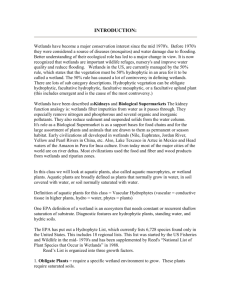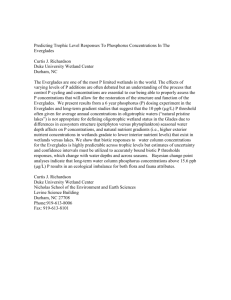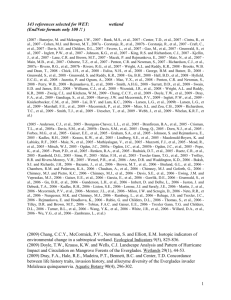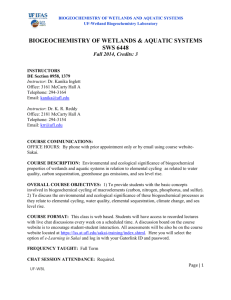Ch 6 & 18 Aquatuc MC review ANSWERS
advertisement
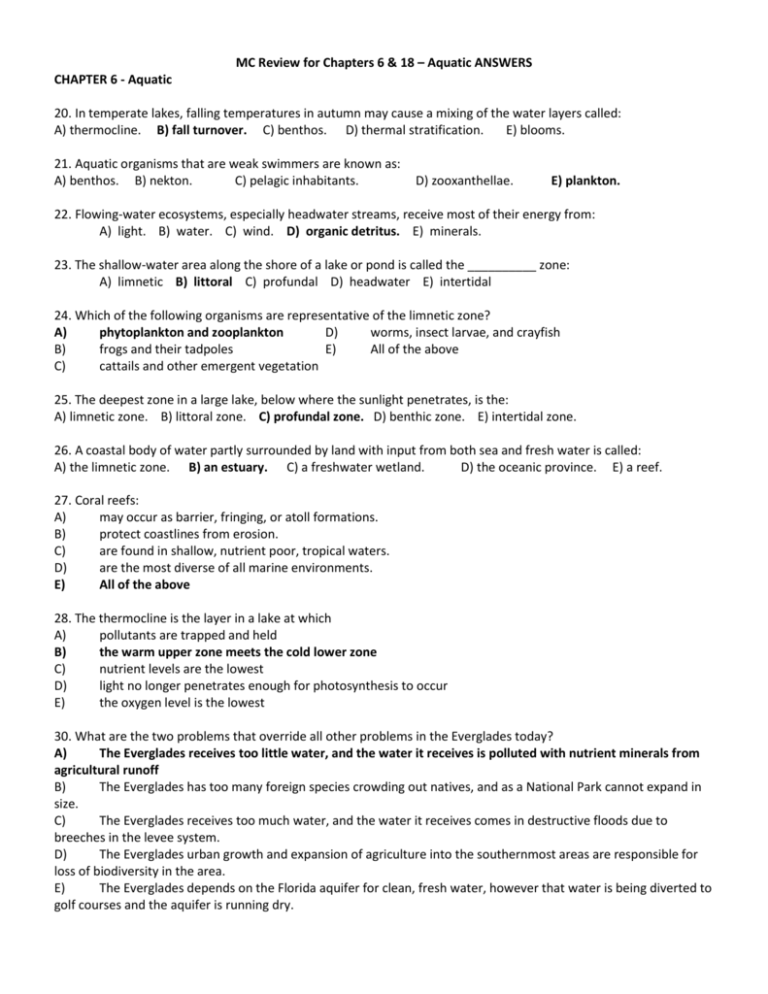
MC Review for Chapters 6 & 18 – Aquatic ANSWERS CHAPTER 6 - Aquatic 20. In temperate lakes, falling temperatures in autumn may cause a mixing of the water layers called: A) thermocline. B) fall turnover. C) benthos. D) thermal stratification. E) blooms. 21. Aquatic organisms that are weak swimmers are known as: A) benthos. B) nekton. C) pelagic inhabitants. D) zooxanthellae. E) plankton. 22. Flowing-water ecosystems, especially headwater streams, receive most of their energy from: A) light. B) water. C) wind. D) organic detritus. E) minerals. 23. The shallow-water area along the shore of a lake or pond is called the __________ zone: A) limnetic B) littoral C) profundal D) headwater E) intertidal 24. Which of the following organisms are representative of the limnetic zone? A) phytoplankton and zooplankton D) worms, insect larvae, and crayfish B) frogs and their tadpoles E) All of the above C) cattails and other emergent vegetation 25. The deepest zone in a large lake, below where the sunlight penetrates, is the: A) limnetic zone. B) littoral zone. C) profundal zone. D) benthic zone. E) intertidal zone. 26. A coastal body of water partly surrounded by land with input from both sea and fresh water is called: A) the limnetic zone. B) an estuary. C) a freshwater wetland. D) the oceanic province. E) a reef. 27. Coral reefs: A) may occur as barrier, fringing, or atoll formations. B) protect coastlines from erosion. C) are found in shallow, nutrient poor, tropical waters. D) are the most diverse of all marine environments. E) All of the above 28. The thermocline is the layer in a lake at which A) pollutants are trapped and held B) the warm upper zone meets the cold lower zone C) nutrient levels are the lowest D) light no longer penetrates enough for photosynthesis to occur E) the oxygen level is the lowest 30. What are the two problems that override all other problems in the Everglades today? A) The Everglades receives too little water, and the water it receives is polluted with nutrient minerals from agricultural runoff B) The Everglades has too many foreign species crowding out natives, and as a National Park cannot expand in size. C) The Everglades receives too much water, and the water it receives comes in destructive floods due to breeches in the levee system. D) The Everglades urban growth and expansion of agriculture into the southernmost areas are responsible for loss of biodiversity in the area. E) The Everglades depends on the Florida aquifer for clean, fresh water, however that water is being diverted to golf courses and the aquifer is running dry. 44. Which of the following is not important in determining the distribution of organisms in aquatic biomes? A) light penetration C) water E) waves and currents B) mineral nutrient concentrations D) salinity 45. Which of the following does not apply to headwater flowing streams? A) small streams C) shallow and swift flowing E) B) usually highly oxygenated D) cold cloudy due to suspended particles 46. Which of the following does not apply to the profundal zone of a large lake? A) no light penetration D) lacks oxygen (anaerobic) B) it is the deepest zone E) a mineral-rich zone C) effective recycling of minerals 47. Which of the following does not apply to freshwater wetlands? A) anaerobic conditions C) water-tolerant vegetation E) B) accumulate organic material D) increase potential for flooding help to purify groundwater 48. Which of the following is not found at the boundary between terrestrial and aquatic ecosystems? A) estuary B) oceanic province C) mangrove forest D) salt marsh E) intertidal zone 49. Ecosystem services supported by the estuarine environment include all of the following except: A) biological habitat. B) trapping pollution. C) groundwater supply. D) storm buffering. E) marinas. 50. Which of the following statements about the Chesapeake Bay is false? A) The Chesapeake Bay is the most productive estuary in the United States. B) Nine rivers and about 150 headwater streams empty their waters into the Chesapeake Bay C) Levels of phosphorous in bay waters have increased since the 1980s along with population growth in the area. D) New oyster reef habitats are being successfully created and colonized within the bay. E) None of the above, all are true 51. What do inhabitants of the rocky intertidal zone not do to protect themselves: A) follow tides in and out B) use an anchor or some other means of attachment. C) seal in moisture with a closing shell or other adaptations D) hide under rocks E) none of the above 52. Which of the following would not be found exclusively in the benthic environment? A) seagrass beds B) coral reefs C) oysters, clams, and barnacles D) kelp forests E) nekton 53. Which of the following pairs is incorrect? A) coral reefs – zooxanthellae B) seagrasses – estuaries (mangroves) C) kelps – large brown algae D) E) benthic environment – mud or sand euphotic zone – photosynthesis 54. Which of the following is not a source of human impact on the marine environment? A) coastal development, both residential and industrial B) global warming C) trash D) increased levels of O2 E) chemical pollution from pesticides, heavy metals, and synthetic chemicals 60. Wetlands are important for all of the following reasons EXCEPT: A) They support high species diversity. B) They reduce flooding by slowing the velocity of runoff water. C) They help recharge groundwater aquifers. D) They contribute to asymmetry in urban communities. E) They sometimes detoxify substances in the water. 61. National Marine Sanctuaries include A) kelp forests off the coast of California B) coral reefs in the Florida Keys C) fishing grounds along the continental shelf D) E) deep submarine canyons all of the above 62. The benthic environment includes all the following accept A) the bathyal zone B) the ocean floor from the intertidal zone to the deep ocean trenches C) the abyssal zone D) the bendal E) the hadal zone 63. Humans harm the oceans in all of the following ways EXCEPT A) Developing along the coast C) Recycling E) With chemicals from agriculture and industry B) Polluting the land D) Killing marine life with trash 64. Which of the following can be found in kelp forests? A) crabs B) tube worms C) sea cucumbers D) sea otters E) all of the above 65. The greatest division in aquatic ecology is A) salinity B) sunlight C) estuaries D) biomes E) differences in sea life CHAPTER 18 - Aquatic 54. All of the following are benefits of coastal wetlands except: A) providing food. D) B) acting as nurseries for many marine organisms. E) C) reducing the impact of ozone depletion. protecting coastlines from erosion. reducing the damage from hurricanes. 55. The policy of no net loss of wetlands in the U.S. is only partially successful because: A) wetland dynamics are not totally understood. Reconstructed wetlands do not always provide the essential elements necessary to attract the species of the original habitat. B) wetlands developed for the drinking water supply do not have to be replaced. This contributes to overall net loss of wetland . C) There is no routine tracking of compliance to document success. D) The definition of wetland was broadened by Congress, adding marginal wetlands in addition to swamps and marshes. E) both a and c 31. Which of the following is not a commercial product of freshwater wetlands? A) blueberries B) cranberries C) grapes D) peat moss E) wild rice 9. All of the following are benefits of coastal wetlands except: A) reduce flooding through their ability to hold excess water B) improved water quality C) reducing the impact of ozone depletion. D) Provide habitat for endangered species E) Produce important commercial products
